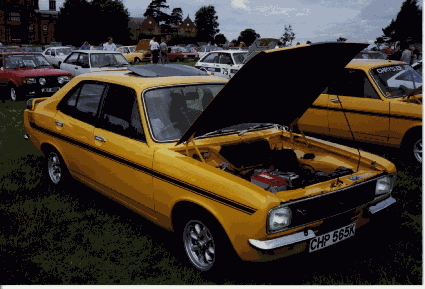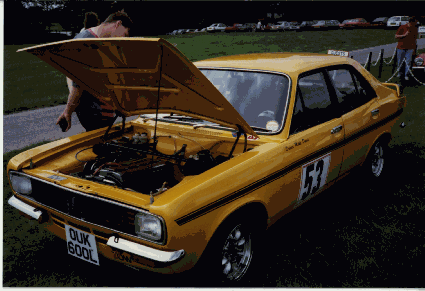Hillman Avenger Tiger
The Hillman Avenger
The Rootes group announced the Hillman Avenger in 1969 as an all new
family vehicle. The timing of the launch came at a point when Chrysler
were in negotiations in taking over the Rootes Group. The vehicle was known
as the Avenger in the UK, its biggest market, but in Europe it was better
known as the Sunbeam. It was later introduced in the USA as the Plymouth
Cricket after Chrysler successfully took over.
The car boasted unconventional styling in the form of square headlamps
and "hockey stick" style taillights. Under the skin though, a conventional
front engine rear wheel drive layout was used.
 Conventional
it may have been, but Rootes used the latest technology where cost permitted.
Where cost were a limiting factor, the best-engineered alternative was
used. For example, the front suspension was MacPherson struts while the
rear suspension employed a four-link axle (five-link on Estate version)
with coil springs. The engine was originally planned to be an overhead
cam crossflow unit but the development and testing costs were beyond the
budget of the group at the time, and so an all new high technology 4 cylinder
push rod unit was designed and built instead.
Conventional
it may have been, but Rootes used the latest technology where cost permitted.
Where cost were a limiting factor, the best-engineered alternative was
used. For example, the front suspension was MacPherson struts while the
rear suspension employed a four-link axle (five-link on Estate version)
with coil springs. The engine was originally planned to be an overhead
cam crossflow unit but the development and testing costs were beyond the
budget of the group at the time, and so an all new high technology 4 cylinder
push rod unit was designed and built instead.
The engine sported many highly engineered features like a high cam location,
which allowed shorter push rods. The short push rods allowed the engine
to be revved with ease to 7000RPM. Many tuned versions would rev to 8000
RPM plus. The inlet and exhaust manifolds where balanced to give equal
flow into and out of all cylinders.
The engine soon became reputed as being the most tuneable engine of
its time. Not so much through popularity, but because of the engine characteristics.
Any attempt at tuning would produce a significant improvement in performance.
It was quite common on the rallying circus to come across 1600cc versions
of the engine producing 150bhp at the flywheel. A figure not frowned on
by today's standards.
The Avenger Tiger
When the Avenger entered into circuit racing and rallies, it was always
second best to the Ford Escort. The superior handling of the Avenger over
the Escort was undeniable, but the lack of power of the GT push rod engine
over the Ford crossflow was marked. The Coventry based Chrysler Competition
Centre under the management of Des O'Dell produced the answer in 1972 in
the form of the Avenger Tiger.

Two versions of the Tiger were produced. The MK1 Tiger was initially
limited to 100 vehicles and were based on the base specification body shell.
Instrumentation was also from the base vehicle with just the addition of
a pod type rev counter mounted on the top of the dashboard. Four auxiliary
lamps were fitted using a Police Car option wiring harness.
Externally, the car was finished in an eye catching Sundance yellow
with black side stripes which turned up over the boot mounted spoiler with
the words Avenger TIGER set into the strip. The bonnet sported
a rather boy racerish bonnet bulge which server no practical purpose.
It was under the bonnet though that the real work had taken place. The
Avenger GT bottom end with it's high compression pistons, duplex timing
chain and sports (GT) camshaft were matched up to a new head with large
inlet and exhaust valves. Breathing was via twin 40 DCOE Weber carburettors.
The exhaust system utilised a tubular manifold connected to a free-flow
exhaust system.
Power was increase from 78bhp for the GT to 92bhp for the Tiger. While
0-60mph was reduced from 11.6 seconds to 9 seconds.
As far as the chassis was concerned, everything was standard GT with
the exception of the front springs which were uprated to 110lb/in. The
rear suspension was also uprated with 100lb/in. springs in conjunction
with Armstong telescopic adjustable dampers. The brakes were standard GT
Avenger with the exception of a smaller 0.625in master cylinder off the
base model but with the addition of a remote Girling Mk. 11B servo.
Specification
Other Avenger Related Web Sites:
Avenger & Sunbeam
Owners Club (ASOC):
The Hillman
Avenger Page:
The
Hillman page:
SOL British Car Clubs of GB:
 Conventional
it may have been, but Rootes used the latest technology where cost permitted.
Where cost were a limiting factor, the best-engineered alternative was
used. For example, the front suspension was MacPherson struts while the
rear suspension employed a four-link axle (five-link on Estate version)
with coil springs. The engine was originally planned to be an overhead
cam crossflow unit but the development and testing costs were beyond the
budget of the group at the time, and so an all new high technology 4 cylinder
push rod unit was designed and built instead.
Conventional
it may have been, but Rootes used the latest technology where cost permitted.
Where cost were a limiting factor, the best-engineered alternative was
used. For example, the front suspension was MacPherson struts while the
rear suspension employed a four-link axle (five-link on Estate version)
with coil springs. The engine was originally planned to be an overhead
cam crossflow unit but the development and testing costs were beyond the
budget of the group at the time, and so an all new high technology 4 cylinder
push rod unit was designed and built instead.

